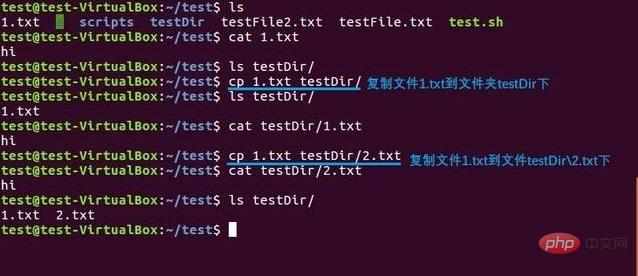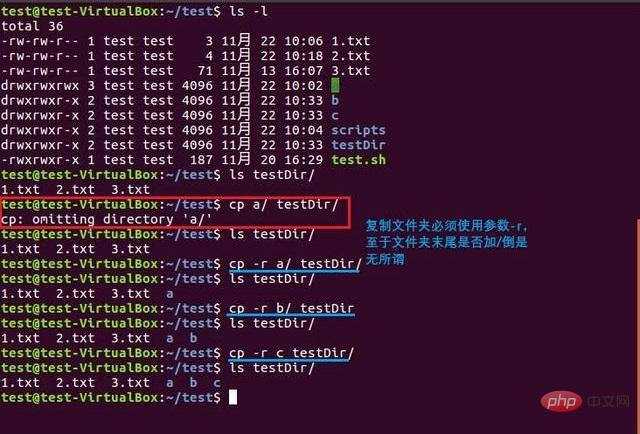 Operation and Maintenance
Operation and Maintenance
 Linux Operation and Maintenance
Linux Operation and Maintenance
 How to use cp command to copy files in linux
How to use cp command to copy files in linux
How to use cp command to copy files in linux
How to use the cp command to copy files in Linux: [cp source file target folder]. For example, if we want to copy the 1.txt file to the testDir directory, we can execute the command [cp 1.txt testDir].

The cp copy command is very practical in Linux. It can copy the file (directory) under the specified path to (into) another file or directory middle.
linux cp copy command
The Linux cp command is mainly used to copy files or directories.
Basic syntax:
cp [options] 源文件 目标文件(夹)
Parameter [options] description:
-a: This option is usually Used when copying a directory, it preserves links, file attributes, and copies all contents under the directory. Its effect is equal to the dpR parameter combination.
-d: Keep the link when copying. The links mentioned here are equivalent to shortcuts in Windows systems.
-f: Overwrite an existing target file without giving a prompt.
-i: Contrary to the -f option, a prompt is given before overwriting the target file, asking the user to confirm whether to overwrite. The target file will be overwritten when answering "y".
-p: In addition to copying the contents of the file, the modification time and access permissions are also copied to the new file.
-r: If the given source file is a directory file, all subdirectories and files in the directory will be copied.
-l: Do not copy files, just generate link files.
linux cp command example
1. Copy a file to the target file (folder)
Format:
cp 源文件 目标文件(夹)
Example: Copy the 1.txt file to the testDir folder and 2.text of the testDir folder respectively

Note:
If the file is copied to a folder, the file name will remain unchanged. If it is copied to a file, the file name will be changed. If the target file already exists or the target folder contains a file with the same name, the target file or the file with the same name in the target folder will be overwritten after copying.
2. Copy multiple files to the target file (folder) at the same time
Format (two types):
cp 源文件1 源文件2 目标文件夹
can be listed Copy multiple files to the target folder at one time, each file is directly separated by spaces
cp 文件* 目标文件夹
uses the wildcard character *, and all files that meet the conditions can be copied to the target folder; for example: *. txt is to copy all files ending with ".txt" to the target folder.
Example: Copy files 1.txt, 2.txt, and 3.txt to the testDir folder


3. Copy a folder to the target file
Format:
cp -r 源文件夹 目标文件夹
Note: You must add the "-r" parameter when copying the folder. Otherwise, the "cp: omitting directory" error will occur.

The above is the entire content of this article, I hope it will be helpful to everyone's study. For more exciting content, you can pay attention to the relevant tutorial columns of the PHP Chinese website! ! !
The above is the detailed content of How to use cp command to copy files in linux. For more information, please follow other related articles on the PHP Chinese website!

Hot AI Tools

Undresser.AI Undress
AI-powered app for creating realistic nude photos

AI Clothes Remover
Online AI tool for removing clothes from photos.

Undress AI Tool
Undress images for free

Clothoff.io
AI clothes remover

Video Face Swap
Swap faces in any video effortlessly with our completely free AI face swap tool!

Hot Article

Hot Tools

Notepad++7.3.1
Easy-to-use and free code editor

SublimeText3 Chinese version
Chinese version, very easy to use

Zend Studio 13.0.1
Powerful PHP integrated development environment

Dreamweaver CS6
Visual web development tools

SublimeText3 Mac version
God-level code editing software (SublimeText3)

Hot Topics
 What computer configuration is required for vscode
Apr 15, 2025 pm 09:48 PM
What computer configuration is required for vscode
Apr 15, 2025 pm 09:48 PM
VS Code system requirements: Operating system: Windows 10 and above, macOS 10.12 and above, Linux distribution processor: minimum 1.6 GHz, recommended 2.0 GHz and above memory: minimum 512 MB, recommended 4 GB and above storage space: minimum 250 MB, recommended 1 GB and above other requirements: stable network connection, Xorg/Wayland (Linux)
 vscode cannot install extension
Apr 15, 2025 pm 07:18 PM
vscode cannot install extension
Apr 15, 2025 pm 07:18 PM
The reasons for the installation of VS Code extensions may be: network instability, insufficient permissions, system compatibility issues, VS Code version is too old, antivirus software or firewall interference. By checking network connections, permissions, log files, updating VS Code, disabling security software, and restarting VS Code or computers, you can gradually troubleshoot and resolve issues.
 How to run java code in notepad
Apr 16, 2025 pm 07:39 PM
How to run java code in notepad
Apr 16, 2025 pm 07:39 PM
Although Notepad cannot run Java code directly, it can be achieved by using other tools: using the command line compiler (javac) to generate a bytecode file (filename.class). Use the Java interpreter (java) to interpret bytecode, execute the code, and output the result.
 Can vscode be used for mac
Apr 15, 2025 pm 07:36 PM
Can vscode be used for mac
Apr 15, 2025 pm 07:36 PM
VS Code is available on Mac. It has powerful extensions, Git integration, terminal and debugger, and also offers a wealth of setup options. However, for particularly large projects or highly professional development, VS Code may have performance or functional limitations.
 What is vscode What is vscode for?
Apr 15, 2025 pm 06:45 PM
What is vscode What is vscode for?
Apr 15, 2025 pm 06:45 PM
VS Code is the full name Visual Studio Code, which is a free and open source cross-platform code editor and development environment developed by Microsoft. It supports a wide range of programming languages and provides syntax highlighting, code automatic completion, code snippets and smart prompts to improve development efficiency. Through a rich extension ecosystem, users can add extensions to specific needs and languages, such as debuggers, code formatting tools, and Git integrations. VS Code also includes an intuitive debugger that helps quickly find and resolve bugs in your code.
 How to check the warehouse address of git
Apr 17, 2025 pm 01:54 PM
How to check the warehouse address of git
Apr 17, 2025 pm 01:54 PM
To view the Git repository address, perform the following steps: 1. Open the command line and navigate to the repository directory; 2. Run the "git remote -v" command; 3. View the repository name in the output and its corresponding address.
 Linux Architecture: Unveiling the 5 Basic Components
Apr 20, 2025 am 12:04 AM
Linux Architecture: Unveiling the 5 Basic Components
Apr 20, 2025 am 12:04 AM
The five basic components of the Linux system are: 1. Kernel, 2. System library, 3. System utilities, 4. Graphical user interface, 5. Applications. The kernel manages hardware resources, the system library provides precompiled functions, system utilities are used for system management, the GUI provides visual interaction, and applications use these components to implement functions.
 How to use VSCode
Apr 15, 2025 pm 11:21 PM
How to use VSCode
Apr 15, 2025 pm 11:21 PM
Visual Studio Code (VSCode) is a cross-platform, open source and free code editor developed by Microsoft. It is known for its lightweight, scalability and support for a wide range of programming languages. To install VSCode, please visit the official website to download and run the installer. When using VSCode, you can create new projects, edit code, debug code, navigate projects, expand VSCode, and manage settings. VSCode is available for Windows, macOS, and Linux, supports multiple programming languages and provides various extensions through Marketplace. Its advantages include lightweight, scalability, extensive language support, rich features and version





